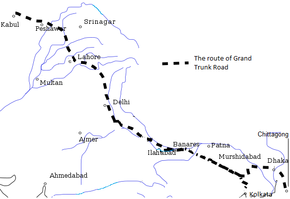Grand Trunk Road (GT Road) is one of the most ancient and longest road of South Asia linking Bangladesh and Afghanistan running across North India and Pakistan. This road was developed in 3rd Century BC in Mauryan Empire and later extended in 16th Century by Sher Shah Suri.

The road was known as Uttarapatha, northern path, during the ancient times. This road was stretched from Tamluk in West Bengal to Taxila in Pakistan. This was the major trade and communications route of the time. It connected the Eastern sea ports to rest of the sub-continent which helped in better transport of goods and services. The road was well managed with plantations on both sides and was supervised by Mauryan military commanders.
In 16th Century, the road was extended by Sher Shah Suri up to Multan in west and Sonargaon in Bengal. The road was further extended by Mughals and reached as far as Kabul in West and Chittagong in East. The road was named as Grand Trunk by Britishers who renovated it. Over the centuries the road was the most major route of trade and postal communication in whole South Asia. The road was dotted with caravansarais, highway hotels, at regular intervals for comfort of passers-by.
Today, the Grand Trunk Road continues to cover a distance of over 2,500 kilometres (1,600 mi). From its origin at Chittagong, it traverses to Sonargaon in the Narayanganj District of central Bangladesh, it reaches India, passing through Kolkata, Bardhaman, Durgapur, Asansol, Dhanbad, Aurangabad, Dehri-on-sone, Sasaram, Mohania, Mughalsarai , Varanasi, Allahabad, Kanpur , Etah, Agra, Mathura , Delhi, Panipat, Karnal, Ambala, Ludhiana, Jalandhar, Amritsar. Within India, the major portion of the road – the stretch between Delhi and Kolkata – is known as NH 2 (National Highway - 2) and that between Delhi and Wagah, at the border with Pakistan, is known as NH-1. It is a part of Golden Quadrilateral. It then continues to Lahore, Rawalpindi and Peshawar all the way up to Khyber Pass in Afghanistan ending up at Kabul.
As with travel in much of the subcontinent, a journey along the GT Road is a bewildering mix of the past and the present, tripping back and forth between the mundane and the momentous. The journey through the road would still testify to the continuing importance of the road, and the vibrant mix of cultures that manage to coexist here. Traces of the Raj are everywhere, but so too are the temples and shrines of older, still-thriving religious-based cultures, as well as the myriad signifiers of India's rapidly changing capitalist society. The road gives first-hand accounts and anecdotes, many of which attest to the ways in which the Grand Trunk Road became the main artery of conquest and rule of northern areas of India from Mauryans to Afghan, Persians and finally British.
In his novel, Kim, Rudyard Kipling describes the Grand Trunk Road, stretching from Calcutta to Kabul, as "a wonderful spectacle" that "runs straight, bearing without crowding India's traffic for fifteen hundred miles – such a river of life as nowhere else exists in the world"!
